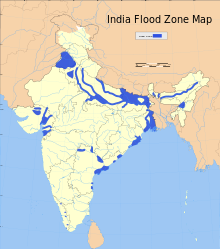Water resources in India includes information on precipitation, surface and groundwater storage and hydropower potential. India experiences an average precipitation of 1,170 millimetres (46 in) per year, or about 4,000 cubic kilometres (960 cu mi) of rains annually or about 1,720 cubic metres (61,000 cu ft) of fresh water per person every year.[1] India accounts for 18% of the world's population and about 4% of the world's water resources. One of the proposed solutions to solve the country's water woes is the Indian rivers interlinking project.[2] Some 80 percent of its area experiences rains of 750 millimetres (30 in) or more a year. However, this rain is not uniform in time or geography. Most of the rains occur during its monsoon seasons (June to September), with the northeast and north receiving far more rain than India's west and south. Other than rains, the melting of snow over the Himalayas after the winter season feeds the northern rivers to varying degrees. The southern rivers, however, experience more flow variability over the year. For the Himalayan basin, this leads to flooding in some months and water scarcity in others. Despite an extensive river system, safe clean drinking water as well as irrigation water supplies for sustainable agriculture are in shortage across India, in part because it has, as yet, harnessed a small fraction of its available and recoverable surface water resource. India harnessed 761 cubic kilometres (183 cu mi) (20 percent) of its water resources in 2010, part of which came from unsustainable use of groundwater.[3][4] Of the water it withdrew from its rivers and groundwater wells, India dedicated about 688 cubic kilometres (165 cu mi) to irrigation, 56 cubic kilometres (13 cu mi) to municipal and drinking water applications and 17 cubic kilometres (4.1 cu mi) to industry.[1]
Vast area of India is under a tropical climate which is conducive throughout the year for agriculture due to favorable warm and sunny conditions provided perennial water supply is available to cater to the high rate of evapotranspiration from the cultivated land.[5] Though the overall water resources are adequate to meet all the requirements of the country, the water supply gaps due to temporal and spatial distribution of water resources are to be bridged by interlinking the rivers of India.[6] The total water resources going waste to the sea are nearly 1200 billion cubic meters after sparing moderate environmental / salt export water requirements of all rivers.[7] Food security in India is possible by achieving water security first which in turn is possible with energy security to supply the electricity for the required water pumping as part of its rivers interlinking.[8]
Instead of opting for centralized mega water transfer projects which would take a long time to give results, it would be a cheaper alternative to deploy extensive shade nets over the cultivated lands for using the locally available water sources efficiently to crops throughout the year.[9] Plants need less than 2% of total water for metabolism requirements and rest 98% is for cooling purpose through transpiration. Shade nets or polytunnels installed over the agricultural lands suitable for all weather conditions would reduce the potential evaporation drastically by reflecting the excessive and harmful sun light without falling on the cropped area.


- ^ a b "India - Rivers Catchment" (PDF). Retrieved 13 July 2016.
- ^ "National Water Policy". greencleanguide.com. September 13, 2014. Archived from the original on September 17, 2013.
- ^ "India is running out of water". Retrieved 13 February 2021.
- ^ Brown, Lester R. (19 November 2013). "India's dangerous 'food bubble'". Los Angeles Times. Archived from the original on 18 December 2013. Retrieved 13 July 2014. Alt URL
- ^ "Potential Evapotranspiration estimation for Indian conditions" (PDF). Retrieved 23 June 2016.
- ^ "India's Water Resources". Retrieved 23 June 2016.
- ^ IWMI Research Report 83. "Spatial variation in water supply and demand across river basins of India" (PDF). Retrieved 23 June 2016.
{{cite web}}: CS1 maint: numeric names: authors list (link) - ^ "India's problem is going to be water not population". The Statesman. Retrieved 21 September 2016.
- ^ "Protected Cultivation" (PDF). Retrieved 23 June 2018.
© MMXXIII Rich X Search. We shall prevail. All rights reserved. Rich X Search
